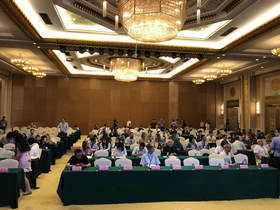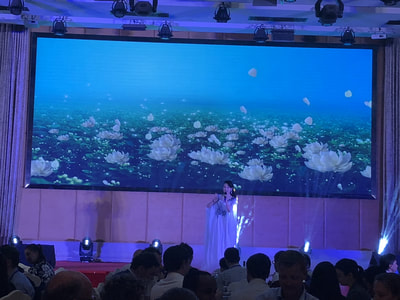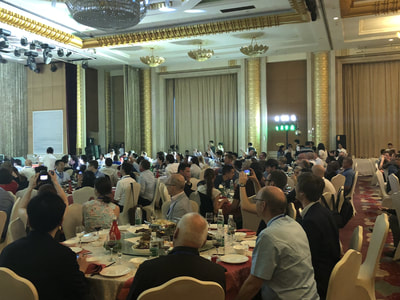|
There is a lot of discussion with regards to how light impacts BSF mating. We all recognize that sunlight is the best light source to stimulate mating in adult BSF; however, given the inconsistency of sunlight throughout the year in various locations around the world, a lot of effort has been invested to develop artificial lights for mass-production of BSF in culture. In fact, there are a number of examples on the market today- some of which you probably read about through this blog. To date, artificial lights stimulating BSF mating are pretty good. Using them results in about 65% of the mating observed when using direct sunlight. Now, that might not sound like good results but if you consider the variability and issues occurring when sunlight is not optimal- these numbers are in fact impressive. At minimum, you are getting consistent mating in doors (albeit other conditions have to be optimal as well, such as humidity). So- how does this dialogue relate to the title of this blog post? Well, a really nice article was published recently in BMC Biology on blow flies. These are the metallic green or blue flies you see associated with decomposing vertebrate remains. Of course, these are not the flies you want to be reproducing in your BSF units; however, we might be able to learn a bit from their biology and eventually adapt it to optimizing the mass production of the BSF. The article in question is: Eichorn, C., M. Hrabar, E. C. Van Ryn, B. S. Brodie, A. J. Blake, and G. Gries. 2017. How flies are flirting on the fly. BMC Biology 15: 2. What I found most interesting about this article is the response of the adult blow fly to light patterns resulting from the wing beat of the female. They determined males actually respond to a set frequency exhibited by the female. They even determined they could use flickering light at a set frequency to attract males. So- why is this important for the BSF and its mass production? Well, I am not sure I have a straight forward answer. But I do have questions with potential answers for you to think about as you develop your colony. 1. Could you use light frequency to segregate flies? So why would you want to do this? My thought is if you have a cage of BSF and mating occurs during the first two days, you could use light frequenting to attract males away from females- isolate them. Doing so could allow you to amp up your mating success by removing females that are potentially already mated- or males that have mated as well. You could infuse your colony with fresh individuals and enhance mating success. Of course, this hypothesis is purely based on the assumption that males/females typically mate once. 2. Optimize light to increase frequency strength. If we can determine the light frequency that enhances the pattern emitted by the female wings, we could potentially allow males to "see" females better thus allow for greater mating success. 3. Shift light patterns during day. This actually gets at the idea that there is an ideal time during the day for males (virgin) to mate. Outside of this window is restricted to males that are desperate for female attention either due to their being old or not virgins (i.e., already mated and thus have nothing to offer). So, you could restrict optimal light intensity during peak periods of the day (most likely between 8-12) so that only active males (virgin) are seeking females. Doing so could reduce the likelihood of unacceptable males (unable to fertilize females due to previous mating) trying to mate with females. 4. What is the proper angle of light in a cage? If wing beat frequency in combination with light is important, determining the proper angle of artificial lights in a cage is critical. If your angle is off a few degrees, males may not see females flying by- and thus miss the opportunity to mate. These are a few ideas from my brief brainstorming session on this paper. In the end- we should always be looking at other insect systems to see what we can learn from them and then apply to the BSF..... so keep reading... and please, share your thoughts! AuthorJeffery K. Tomberlin, PhD, BSF behavior specialist
0 Comments
Mass production of the BSF in colony is the heartbeat of all BSF facilities. I think we all recognize this aspect of BSF production. If you do not have adults mating and producing fertile eggs, you have a problem. So, a lot of effort has been placed on creating an ideal "love nest" for the adults to ensure maximum production of fertile BSF eggs (and their collection) is achieved. Through this process, a lot has been determined with regards to the need for proper light and other abiotic conditions (e.g., temperature and humidity) to allow for success. One aspect of adult BSF behavior that has always intrigued me is the basic mating sequence that takes place between male and female BSF in a cage. Males sit around guarding a position and if another individual enters the "realm" of the male, he will either chase the male away or attempt to mate with the female. Now, I have to admit, there is a fair amount of speculation on my part with that statement. For all we know, males treat other males no different than a female entering their zone of influence. However, biology would dictate for efficiency sake that males would be able to recognize another male and distinguish him from a potential mate. Is this true? I am not sure can answer this question right now- but it is definitely something worth exploring. So, how does this discussion relate to the title of this blog post? Well, a great study came out a couple of years ago examining the balancing organ (haltere) of the BSF that allows for it to navigate during flight. This topic is very relevant to the opening discussion as the male must be able to, with precision, locate the female, grab her, and gain access so he can deposit sperm for egg fertilization. Failure to do so could be the difference between mating and not mating successfully. Article to Read: Parween, R., and R. Pratap. 2014. Modelling of soldier fly halteres for gyroscopic oscillations. Biology Open. The reason I would like you to read this paper is the authors did a great job describing the haltere of the BSF and its morphology and physiology. What I found fascinating is the flexibility of the organ (ability to bend). This aspect of the haltere is very relevant to mating and the abiotic factors regulated in your cages. Humidity can increase or decrease the flexibility of the haltere due to his physiological makeup. Humidity too high could increase flexibility, while low humidity potentially would do the opposite. If this is the case- then determining the Goldilocks zone of humidity (the ideal range) would be critical to allow for males to fly with precision and efficiency when it comes to locating a mate. Too high or low- and the male will be off course and strike out with his potential mate. Definitely food for thought... what do you think is the ideal humidity range for the adult BSF? AuthorJeffery K Tomberlin, PhD, Amazed by Physics and Biology  Group Photo of those in attendance at the Insects Feed the World (IFW) Conference in Wuhan, China 15-18 May 2018.  Overview: What can I say other than my colleagues at Huagzhong Agricultural University did a magnificent job organizing this conference. It should be noted that four sites have been proposed for the 2020 IFW: 1) Mexico, 2) USA, 3) Canada, and 4) South Africa. Great seeing friends/colleagues- just not enough time to catch up: Alex, Moritz, Longyu, Jibin, and many more! Sponsorship: A number of industry groups provided support for the conference. It was great to see so much dedication to the event. Results: 40 countries 278 participants 104 platform presentations 17 keynote presentations 61 posters What was most amazing is that roughly 60-70% of the material presented was on the BSF! Symposia Topics Included: •Feed production systems •Farming insects •Ethno-entomology •Marketing and economics •Feed production systems •Farming insects •Environmental impact •Consumer attitudes •Insect diseases •Insects as diets •Processing organic side streams •Ethics, food safety, legislation, and policy •Nutrition & conservation •Round table (associations) •Joint action (white paper) discussion Entertainment: There was great entertainment during the dinner session. What a great cultural experience with music, song, food, and drink! Future Meetings: There are a number of meetings coming up- if you have time, try to attend one or more of them. AuthorJeffery K. Tomberlin, PhD, Exhausted from travel What great time for a review on the black soldier fly and its associated microbial community! With the Insects Feed the World Conference happening in a couple of weeks in Wuhan, China, and the number of presentations on microbiology and the BSF scheduled, this paper will serve as a great way for any attending the conference to prep their knowledge beforehand. The article was published in Applied and Environmental Microbiology just a month or so ago. The title is: Microbial Community Dynamics during Rearing of Black Soldier Fly Larvae (Hermetia illucens) and Impact on Exploitation Potential I am not sure if it is available open access or not. So, at minimum, here is the link to the abstract. The authors did a superb job summarizing what is known at present, while also identifying potential research topics for the future. One take home message is that really there is not too much known at this time (of course, this statement is relative in terms of what is known about microbiology for other species or the topic in general). They break the discussion down into the following topics: 1- Gut microbiome 2-Impact of substrate composition on Hermetia illucens development 3-Microbial community of Hermetia illucens larvae on natural substrates 4-Functions of the microbial community during the life cycle of Hermetia illucens (digestion/oviposition/detoxification)- as a side note, I love seeing researchers use the term inter kingdom with such discussion points (check out my papers in Chemical Ecology, Animal Behaviour or BioEssay to understand my point- I truly believe microbes drive most behavior observed by invertebrates and vertebrates alike) 5-Impact of microbial community manipulation on Hermetia illucens (growth/pathogen reduction) 6-Exploitation of antibacterial properties of Hermetia illucens (BSF as additive to aid host immunity/modulation of larval immunity/search for antibacterial compounds) I really like this paper and wish to congratulate my colleagues on a most excellent job! This paper is a definite must read for anyone interested in the BSF AuthorJeffery K. Tomberlin, PhD, Excited about this paper! I wanted to post a quick note about a publication that is available now. The book is entitled Waste Biorefinery and it is published by Elsevier. I along with Dr. Samir Khanal et al at the University of Hawaii (you can check out his lab) have a chapter on insects and biorefineries. You can at minimum read the abstract at their website. Chapter 22 – Insect-Based Biorefinery for Bioenergy and Bio-Based Products While energy costs in the USA are fairly low at the moment, these matters change quickly, and we as a society should always be positioned to be more efficient with the resources available to us now. This chapter really demonstrates another benefit of using insects to recycle wastes. They not only have the potential to protect the environment from wastes but also could be utilized to produce bio-energy (e.g., heat or biodiesel). I hope you enjoy it. AuthorJeffery K Tomberlin, PhD, Author of new publication! |
AuthorIndividuals with over 25 years research experience with the black soldier fly. We are passionate about the science behind the black soldier fly and its ability to convert waste to protein. Get Notified Here
Archives
September 2022
Categories
All
Install an RSS app to get notified from us when a new post is up!
|
ServicesSupport |
About |






 RSS Feed
RSS Feed

